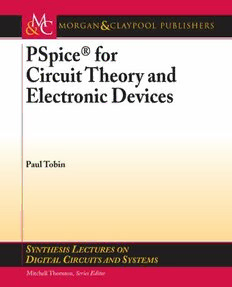Download PSpice for Circuit Theory and Electronic Devices PDF Free - Full Version
Download PSpice for Circuit Theory and Electronic Devices by Paul Tobin in PDF format completely FREE. No registration required, no payment needed. Get instant access to this valuable resource on PDFdrive.to!
About PSpice for Circuit Theory and Electronic Devices
PSpice for Circuit Theory and Electronic Devices is one of a series of five PSpice books and introduces the latest Cadence Orcad PSpice version 10.5 by simulating a range of DC and AC exercises. It is aimed primarily at those wishing to get up to speed with this version but will be of use to high school students, undergraduate students, and of course, lecturers. Circuit theorems are applied to a range of circuits and the calculations by hand after analysis are then compared to the simulated results. The Laplace transform and the s-plane are used to analyze CR and LR circuits where transient signals are involved. Here, the Probe output graphs demonstrate what a great learning tool PSpice is by providing the reader with a visual verification of any theoretical calculations. Series and parallel-tuned resonant circuits are investigated where the difficult concepts of dynamic impedance and selectivity are best understood by sweeping different circuit parameters through a range of values. Obtaining semiconductor device characteristics as a laboratory exercise has fallen out of favour of late, but nevertheless, is still a useful exercise for understanding or modelling semiconductor devices. Inverting and non-inverting operational amplifiers characteristics such as gain-bandwidth are investigated and we will see the dependency of bandwidth on the gain using the performance analysis facility. Power amplifiers are examined where PSpice/Probe demonstrates very nicely the problems of cross-over distortion and other problems associated with power transistors. We examine power supplies and the problems of regulation, ground bounce, and power factor correction. Lastly, we look at MOSFET device characteristics and show how these devices are used to form basic CMOS logic gates such as NAND and NOR gates.
Detailed Information
| Author: | Paul Tobin |
|---|---|
| Publication Year: | 2007 |
| ISBN: | 9781598291568 |
| Pages: | 174 |
| Language: | English |
| File Size: | 26.335 |
| Format: | |
| Price: | FREE |
Safe & Secure Download - No registration required
Why Choose PDFdrive for Your Free PSpice for Circuit Theory and Electronic Devices Download?
- 100% Free: No hidden fees or subscriptions required for one book every day.
- No Registration: Immediate access is available without creating accounts for one book every day.
- Safe and Secure: Clean downloads without malware or viruses
- Multiple Formats: PDF, MOBI, Mpub,... optimized for all devices
- Educational Resource: Supporting knowledge sharing and learning
Frequently Asked Questions
Is it really free to download PSpice for Circuit Theory and Electronic Devices PDF?
Yes, on https://PDFdrive.to you can download PSpice for Circuit Theory and Electronic Devices by Paul Tobin completely free. We don't require any payment, subscription, or registration to access this PDF file. For 3 books every day.
How can I read PSpice for Circuit Theory and Electronic Devices on my mobile device?
After downloading PSpice for Circuit Theory and Electronic Devices PDF, you can open it with any PDF reader app on your phone or tablet. We recommend using Adobe Acrobat Reader, Apple Books, or Google Play Books for the best reading experience.
Is this the full version of PSpice for Circuit Theory and Electronic Devices?
Yes, this is the complete PDF version of PSpice for Circuit Theory and Electronic Devices by Paul Tobin. You will be able to read the entire content as in the printed version without missing any pages.
Is it legal to download PSpice for Circuit Theory and Electronic Devices PDF for free?
https://PDFdrive.to provides links to free educational resources available online. We do not store any files on our servers. Please be aware of copyright laws in your country before downloading.
The materials shared are intended for research, educational, and personal use in accordance with fair use principles.

